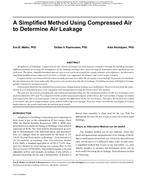Description
Airtightness of buildings is important for the control of energy loss and moisture transport through the building envelope. Different methods for testing the airtightness of the building envelope have been developed. Sometimes these methods are too elaborate. Therefore, simplified methods that are easy to use can be most useful for rough estimates of airtightness. An alternative simplified method using compressed air from a cylinder was suggested, developed, and tested in this research.
Compressed air was released inside a house and the pressure rose. After the air supply was turned off, the pressure normalized; the rate of pressure decrease induced by this process was used to describe the air leakage. A building envelope with high air leakage quickly returned to normal pressure.
A theoretical model for the relation between pressure change and air leakage was established. Then test results from the experiments in two detached houses were compared with measurements using the blower door test method.
The pressure decreased systematically and with good reproducibility, but the calculated airflows in the two test houses were underestimated by 50% and 7% compared with the airflow measured by means of the blower door test method. Changes in volume and temperature due to pressurization could not explain the differences in the two test houses. Therefore, the method was stated to be usable only for a rough estimate of the airflow with a big error margin. However, better instruments and higher pressures might improve the results and make the method more useful.
Citation: Thermal Performance, International Conference, 2010
Product Details
- Published:
- 2010
- Number of Pages:
- 11
- File Size:
- 1 file , 530 KB
- Product Code(s):
- D-BUILDINGSXI-57




